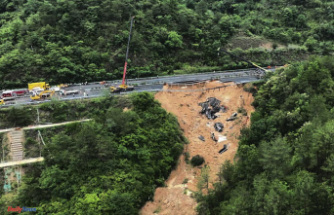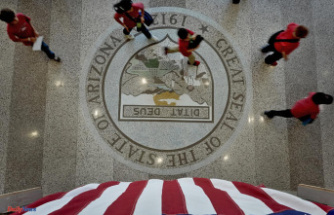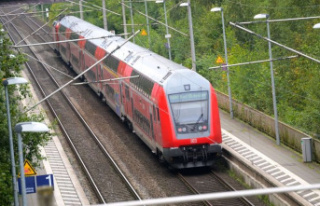Nothing works in Austria's fourth largest city without Wolfgang Amadeus Mozart. The composer was born in Salzburg in 1756 and began his career here, the world's first statue of Mozart is in his hometown, he is the airport's namesake, and one of the top music festivals on the planet is held in his honor every year, the Salzburg Festival.
The souvenir industry also benefits from the city's best-known son, as evidenced by the countless Mozart balls and Mozart liqueur bottles that are sold each year. But Salzburg is also worthwhile beyond Mozart and music - thanks to the baroque splendor of the old town and the location in the foothills of the Alps; some mountains stretch picturesquely into the city area.
Even the journey by train from Munich is a highlight: the Alps gradually come into view, you pass Lake Chiemsee, and finally the multi-towered silhouette of the city with Hohensalzburg Fortress towering over it appears.
The main train station – opened in 1860, rebuilt and enlarged in 1909, expanded with a futuristic roof structure from 2009 to 2014 – is itself a small sight. The old reception building, painted creamy white, is still largely intact and is a listed building, also because of its lovingly restored Art Nouveau elements. Since several DB regional train routes from Bavaria end in Salzburg, the city can currently also be reached conveniently with the 9-euro ticket.
The best way to get around is on foot, the old town is pedestrian and compact. Public transport is well developed, with the Salzburg Card (24 hours: 30 euros, 72 hours: 45 euros) you can use all buses, go to every museum once and drive up the Mönchsberg and Hohensalzburg Fortress.
The Mozart birthplace in Getreidegasse is one of the most visited museums in Austria. It was opened in 1880 and gives a deep insight into "Wolferl's" life on a tour of the original living quarters - with furniture from the 18th century, original letters, oil ham with Mozart portraits and as audience favorite Mozart's children's violin.
If you're lucky, you can get tickets for the Mozart matinees at the Salzburg Festival. If you don't succeed, you can console yourself with the original Mozartkugeln - they have been Salzburg's culinary landmark since 1890 and were invented that year by pastry chef Fürst, a round, hand-made chocolate praline with a pistachio-marzipan core and nougat; it is the true original, recognizable by the silver colored case with blue printing.
All sorts of pastry shops and shops now offer their own Mozartkugeln. Which tastes best is a matter of taste, as is the answer to the question of whether Mozart's "Magic Flute" is better than the opera "Don Giovanni".
The largest sphere in Salzburg is on Kapitelplatz below the fortress. The two-ton golden sphere with a diameter of five meters was created by the sculptor Stephan Balkenhol and is also jokingly called the Balkenhol Mozart sphere. It is the best-known modern work of art in the city, deliberately contrasting with the historical heritage.
If you are looking for something higher and more art, you can take the elevator to the Mönchsberg. Not only because of the beautiful view, but also to enjoy art from the 20th and 21st centuries in the Museum der Moderne.
You can also go high up on the 640-metre-high Kapuzinerberg on the right bank of the Salzach, with a walk through nature, to chapels and to the Capuchin monastery. All good hills come in threes: there are several museums in Hohensalzburg Fortress – if you don't want to walk up there, you can take the funicular.
And then back down into the fray! With its treasures, Salzburg's old town looks like a lavishly stocked box of chocolates. Traditional shops can be found on Getreidegasse, where you can buy real costumes, for example – at Theresa Lanz, a hand-tailored dirndl can cost over 1,000 euros.
Lederhosen have been made in the Jahn-Markl tannery since 1408; Karl Lagerfeld and Vivienne Westwood have signed the guest book. Knopferlmayer is also wonderfully old-fashioned, where buttons to match every blouse and shirt have been available for sale since 1758.
The through-houses typical of Salzburg are passages for pedestrians, they invite you to discover the side streets - for example, you can slip from Getreidegasse through the auditorium through-house to Universitätsplatz and then take a baroque tour of the cathedral, new residence and collegiate church. Afterwards, it is best to take a break in one of the many Salzburg cafés, where the most delicious apricot dumplings are in season.
You live quietly and close to the center in the "Altstadthotel Wolf Dietrich", named after Prince Archbishop Wolf Dietrich von Raitenau (1559-1617). The Catholic churchman had Mirabell Palace built for Salome Alt, his partner and mother of his 15 children, just as most of baroque Salzburg was built under his rule (double rooms from 135 euros, salzburg-hotel.at).
Of course, there is also a hotel dedicated to the most famous Salzburg resident: "The Mozart", a modern classic since 2019, which emerged from the completely renovated "Hotel Mozart", which has been modernized but managed to retain its charm (double rooms from 159 euros , themozarthotel.com).
People meet for an aperitif in the guest garden of the "Hagenauerstuben" at the back exit of Mozart's birthplace. The restaurant advertises that it has been entertaining guests since Mozart's time. Here you should try a Mönchsberg Sparkling, a rosé straight from Salzburg.
If you prefer beer, go to "Die Weisse", Salzburg's oldest wheat beer brewery from 1901, where pork roast and Pinzgauer Kasnocken are served, along with a local beer - also popular with locals. Inside a traditional restaurant, outside a beautiful beer garden.
Even older is the “St. Peter Stiftskulinarium" - the origins of the restaurant go back to the year 803, it advertises that it is Europe's oldest restaurant, where the Mozart family used to come for dinner. You can choose between gourmet cuisine in the "Genussstube 803" and Austrian-Mediterranean fusion dishes in the "Peter".
A must is the "Café Tomaselli" on the Alter Markt, the oldest coffee house in Austria, whose predecessor was founded in 1700. Here, too, people boast about Mozart, who was a frequent guest. However, the criticism with which the composer once overwhelmed the innkeeper is elegantly concealed: "Patron of the Cóffè soup soup, the mildewed lemonade, the almond milk without almonds and the frozen strawberry full of eysbrocken."
Anyone who stops by here today will be relieved to find that Mozart has nothing to complain about. The more than 20 different pastries, from the Salzburger-Nockerl-Schnitte to the croissants made of butter dough with walnut filling and sugar-rum glaze, are so stunning that you could easily spend half of your Salzburg holiday at the "Tomaselli".
Information: salzburg.info/de
Participation in the trip was supported by Salzburg Tourismus. You can find our standards of transparency and journalistic independence at axelspringer.com/de/Werte/downloads.
Apart from a few congested trains, the 9-euro ticket is well received. Some want to extend the success. For example, with a monthly 69-euro ticket for local public transport. However, the Ministry of Transport reacted rather cautiously to the proposal of the transport company.
Source: WELT / Sebastian Plantholt












